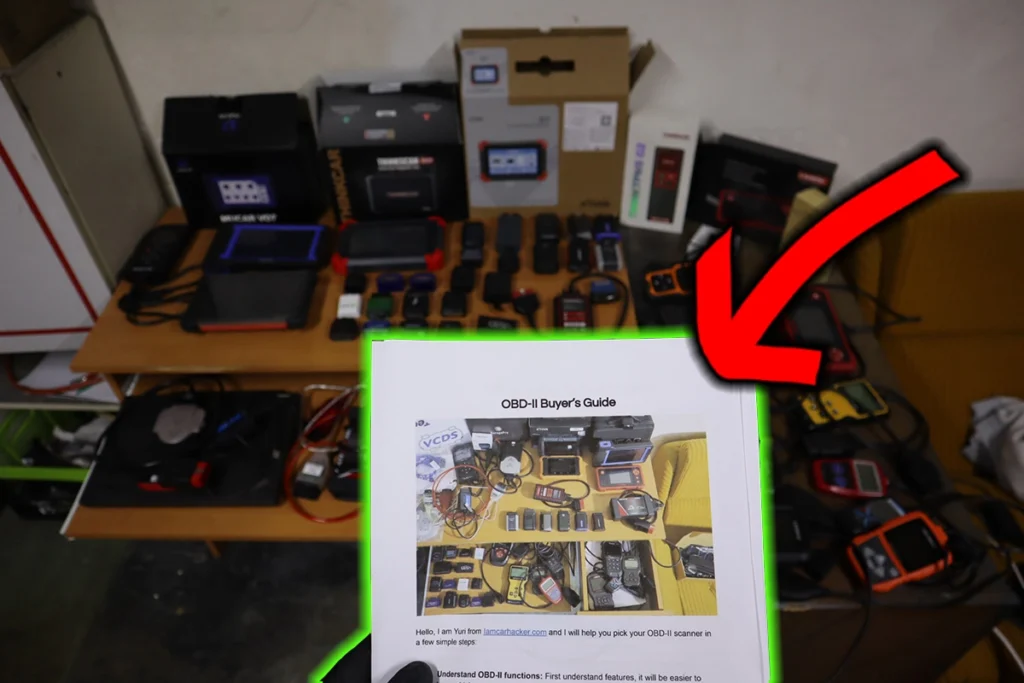The OBD2 code P2251 relates to an issue within the oxygen (O2) sensor’s negative current control circuit for bank 1, sensor 1. This sensor is crucial for optimizing fuel mixture by measuring the amount of oxygen in the exhaust, allowing the engine control module (ECM) to adjust fuel delivery accordingly. An open circuit in the O2 sensor’s negative current control can lead to inaccurate oxygen level readings, affecting engine performance, fuel economy, and emissions.
P2251 quick overview
| Meaning | P2251: O2 Sensor Negative Current Control Circuit/Open Bank 1 Sensor 1 |
| Is it serious? | Yes, it can impact fuel efficiency, emissions, and overall engine performance. |
| Possible causes | – Faulty O2 sensor – Wiring issues in the O2 sensor circuit (open, shorted, or high resistance) – Poor electrical connections in the O2 sensor circuit – Faulty ECM |
| How to diagnose? | Inspect the O2 sensor wiring and connectors for damage or corrosion. Test the O2 sensor for proper operation. Check the ECM and associated circuits for faults. Monitor live data to assess O2 sensor functionality. Replace the O2 sensor with OEM parts if testing confirms failure. |
P2251 Meaning
When your car’s computer throws the P2251 code, it’s like saying it can’t properly listen to one of its key sensors for managing how much fuel goes into the engine. The sensor, located in the exhaust system, tells the computer how much oxygen is being expelled so it can adjust fuel amounts to run efficiently.
If the sensor or its wiring has a problem, the computer might get incorrect information, leading to a car that runs rough, uses too much fuel, or emits more pollution than it should. Fixing this issue often involves checking the sensor and its connections or replacing it altogether.
Free PDF: How to choose OBD2 scanner

I’ve made you a free PDF to choose the OBD2 scanner in 5 minutes.
✅ Which OBD2 scanner is best?
✅ Which type should you get (DIY, Pro, Hobby)
✅ What is the best scanner for the exact brand/feature (e.g best for BMW)
✅ How to get a Bi-Directional tool for as cheap as $40
✅ Discount coupons for scanners
PDF is 100% free and it is designed to help you pick a scanner in less than a few minutes! Not a boring 50-page guide.
Just tell me where to send it.
How to fix P2251 – learn from mechanics
I looked into P2251 service cases at iatn.com website where in the private forums the mechanics seek advice from other mechanics. I looked up a bunch of cases to help you decide how to fix your issue and see what would a real mechanic do to solve it.
Case #1: Honda
Vehicle Information:
2003 Honda Accord EX 3.0L
Issue + Repair History:
- MIL light is on.
- Codes: P0134 (Rear Air Fuel Sensor Bank 1 Sensor 1 Heater), P2251 (Rear Air Fuel Sensor Bank 1 Sensor VS Line High Voltage).
- Front sensor (bank two sensor one) replaced by another shop, but it was for the wrong bank.
- Symptoms: Codes indicating sensor issues, plus unusual behavior observed in sensor output.
Other OBD2 Codes + Test Results:
- OBD2 Codes: P0134, P2251
- No other codes provided.
Mechanic Suggestions:
- Check the heater circuit for open or shorted connections, as the sensor has 4 wires with 2 for the heater. Replacement recommended since the code indicates a sensor range issue, not affecting engine performance.
- Monitoring with a scan tool is the only way to assess the sensor; probing with a voltmeter won’t yield useful results.
- Focus on checking the heater wires and fuse for any open circuits, considering the specific sensor location (bank 1 sensor 1).
- Follow troubleshooting procedures outlined in repair manuals, or simply replace the sensor if unsure.
- Replacement with OEM or Denso sensor recommended, as aftermarket sensors may not function correctly.
Final Fix:
- Replaced the rear sensor with an OEM sensor, resolving the issue. Despite previous attempts to diagnose the sensor, replacement proved to be the most effective solution.
Case #2: Volkswagen
Vehicle Information:
2007 Volkswagen Jetta 2.5 2.5L
Issue + Repair History:
- Engine ran 3 quarts low on oil, leading to poor running symptoms.
- Codes: P0011 (Intake Cam Retard Set Point not reached), multiple misfires, throttle valve controller and actuator issues, oxygen sensor codes.
- Suspected engine timing issue due to low oil condition.
- ECM relay fault code (P0688) detected multiple times.
- Engine starts and runs but exhibits hesitation and poor performance above 2,000 RPM.
Other OBD2 Codes + Test Results:
- OBD2 Codes: P0688 (ECM Relay J271 Open Circuit), P1545 (Throttle Valve Controller – Intermittent), P2106 (Throttle Valve Actuator – Intermittent), P2251 (B1S1 Negative Lead Open Circuit), P0130 (B1S1 Malfunction in Circuit).
- No specific test results mentioned other than fault codes.
Mechanic Suggestions:
- Check upper cam chain and tensioner for wear or damage.
- Verify engine timing marks to determine if timing has jumped.
- Check wiring for faults, especially related to throttle body and cam/crank sensors.
- Consider the possibility of a faulty upper timing chain tensioner.
- Investigate the high-pressure fuel pump cam follower for wear due to low oil condition.
- Focus on resetting adaptations for throttle body and pedal position after clearing fault codes or battery disconnection.
- Monitor voltage in block values while driving to identify potential electrical issues.
- Consult factory scan tool for detailed wiring diagrams, as some late-model VW diagrams may only be available through the scan tool.
Final Fix:
- Discovered missing fuses in the engine compartment fuse box, specifically a 120 AMP fuse.
- Replaced missing fuses and cleared fault codes again.
- Reset system base settings for the engine and transmission downshift.
- Vehicle exhibited normal operation afterward, indicating that missing fuses were likely causing the issues.
Case #3: Volvo
Vehicle Information:
2006 Volvo S60 2.5T 2.5L
Issue + Repair History:
- Car came in with two OBD2 codes: ECM-24AB (Front O2 Sensor, Bank 1) and ECM-243C (Front O2 Sensor, Bank 1 Heating, Signal Missing).
- Customer had previously replaced both O2 sensors with Bosch sensors.
- Technician tried factory Volvo sensors but issue persisted after about 5 minutes of driving.
- All wiring from the front O2 sensor to the ECM and the preheater circuit up to the 20 amp fuse were checked and found to be okay.
- Suspected issue with the ECM not recognizing that the preheater circuit was turned on.
- Fuel trims appeared to be within specifications.
- Occasional odor detected from the tailpipe.
Mechanic Suggestions:
- Confirm all voltages at the O2 sensor connector are correct.
- Perform a hard reset on the ECM to potentially resolve the issue.
- Reset adaptations for fuel control systems, as sometimes adaptations may not reset properly after code clearing.
- Verify ECM software is up to date using VIDA.
- Check PCV system operation and intake for restrictions that may affect fuel trim.
- Inspect throttle body for excessive carbon buildup.
- Perform checks on MAF sensor reading, air intake integrity, and fuel pressure control.
- Focus on verifying the proper operation of the O2 sensor heating circuit. Plug in the old sensor and run the engine to see if it heats up quickly.
- Monitor the current flow in the heater circuit using an amp meter to diagnose potential issues with the ECM recognizing the circuit or faults in the power and ground connections.
- Ensure the ECM is fully inserted into its connector, as improper installation may cause intermittent connections.
Final Fix:
- Replaced the pin terminal for #5 at the O2 sensor end of the harness and #42 at the ECM end of the harness.
- After driving through a complete drive cycle, the issue did not return, whereas before it would reappear instantly.
- Resistance in the terminals was slightly high, but not excessively so.
- This repair was attempted as a last resort and resolved the issue, indicating that the original terminals may have had subtle faults despite appearing tight and corrosion-free.
How to diagnose P2251
I made you an overview of solving this DTC, based on all the advice that was suggested by certified mechanics to address this issue in previously mentioned service cases.
| Diagnostic Step | Brief Explanation |
|---|---|
| Inspect the O2 sensor wiring and connectors | Look for any signs of damage, corrosion, or loose connections. |
| Test the O2 sensor | Evaluate the sensor’s function with a multimeter or scan tool. |
| Check the ECM and associated circuits | Ensure there are no faults in the ECM that could lead to the issue. |
| Monitor live data | Use a scan tool to verify the O2 sensor’s responsiveness and output. |
| Replace the O2 sensor with OEM parts | If faulty, replacing the sensor with an OEM part is recommended for compatibility and performance. |
In these service cases, the P2251 code was addressed through careful diagnosis and targeted repairs, from replacing faulty sensors to repairing damaged wiring. These examples underscore the importance of thorough inspection and the use of OEM parts for ensuring repairs are effective and durable. Whether dealing with a Honda, Volkswagen, or Volvo, understanding the role and proper functioning of the O2 sensor in the vehicle’s emission control system is key to resolving the P2251 code.
Free PDF: How to choose OBD2 scanner

I’ve made you a free PDF to choose the OBD2 scanner in 5 minutes.
✅ Which OBD2 scanner is best?
✅ Which type should you get (DIY, Pro, Hobby)
✅ What is the best scanner for the exact brand/feature (e.g best for BMW)
✅ How to get a Bi-Directional tool for as cheap as $40
✅ Discount coupons for scanners
PDF is 100% free and it is designed to help you pick a scanner in less than a few minutes! Not a boring 50-page guide.
Just tell me where to send it.

Hi, I am Juraj “Yuri” Lukacko. I got frustrated by unhelpful and scammy mechanics, so I decided to learn everything about car diagnostics myself. I test dozens of new car diagnostic tools every month along with learning new strategies to fix and customize cars. About Juraj Lukacko (Yuri)